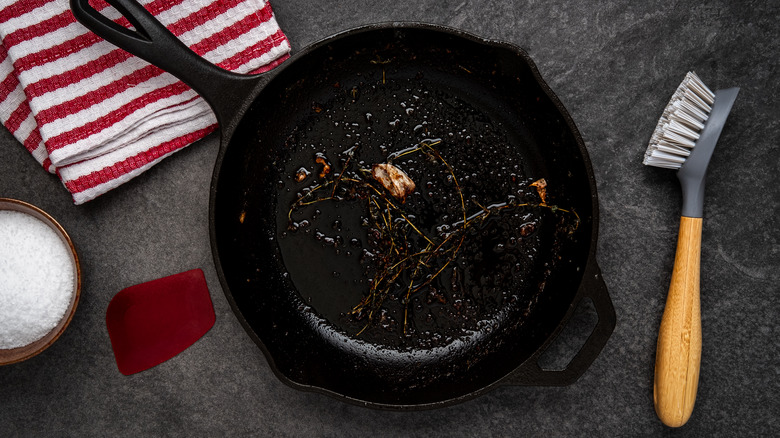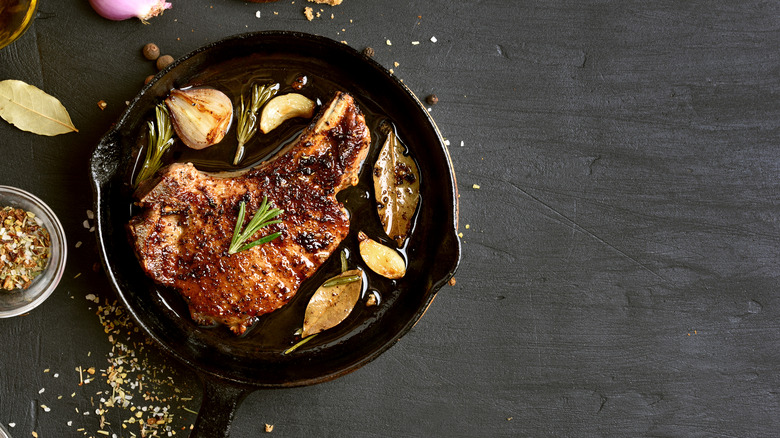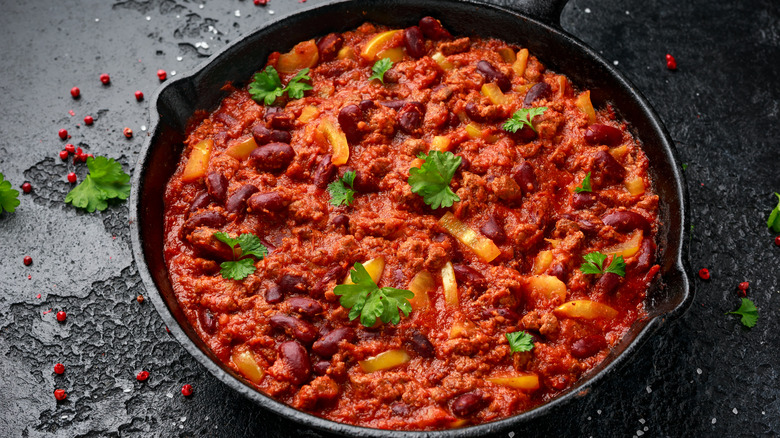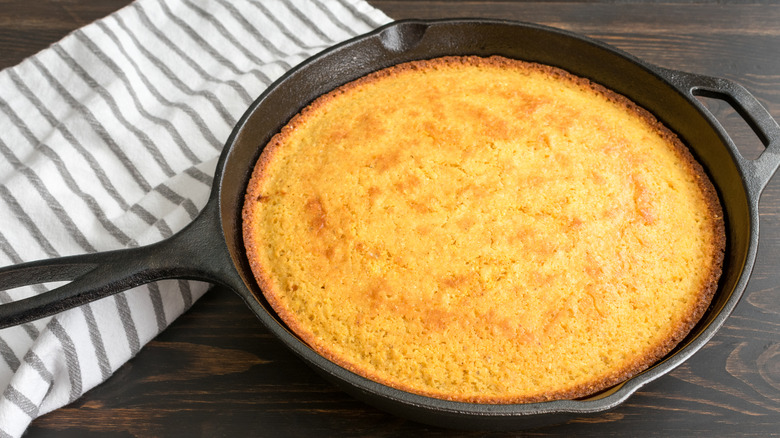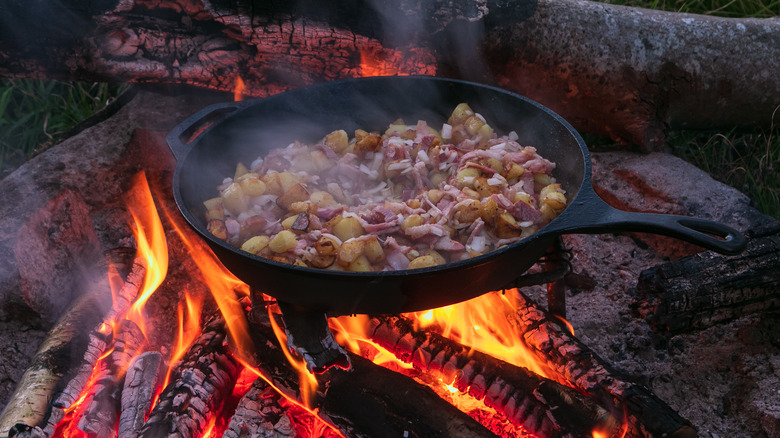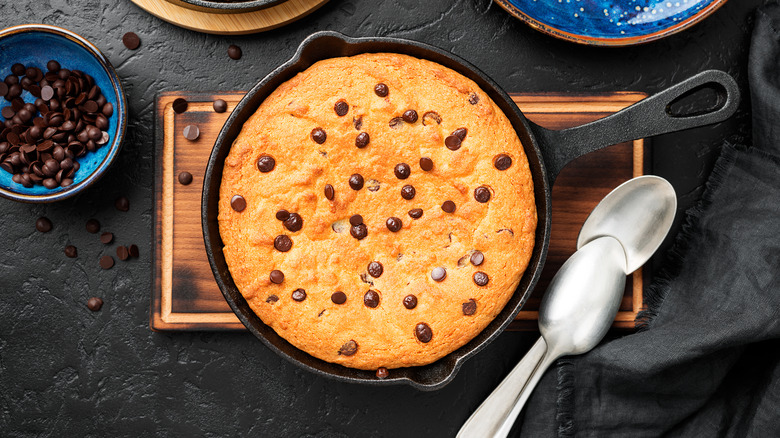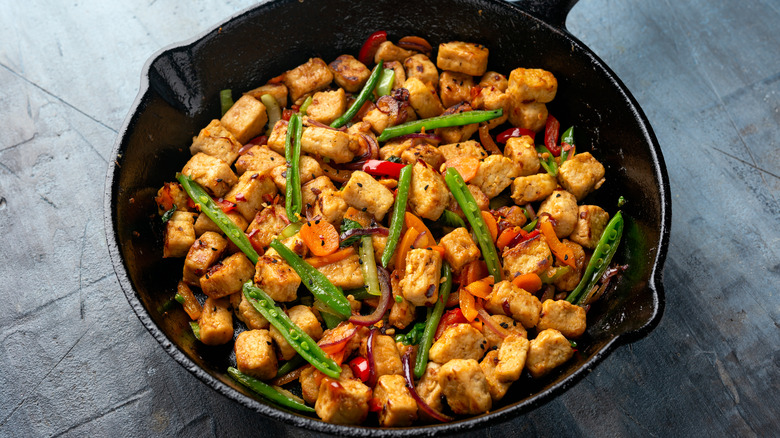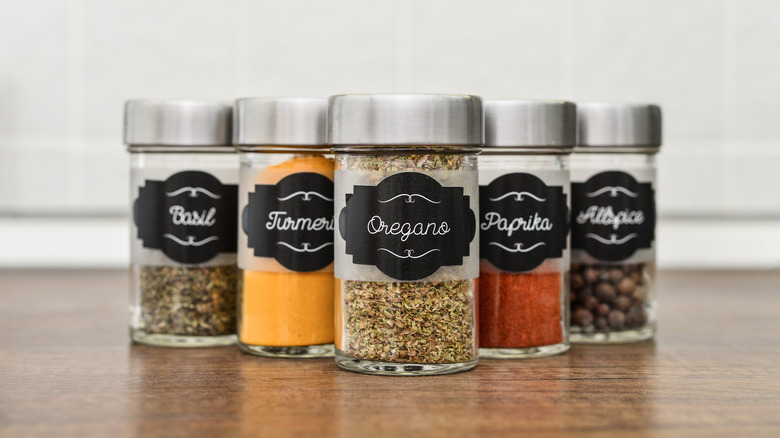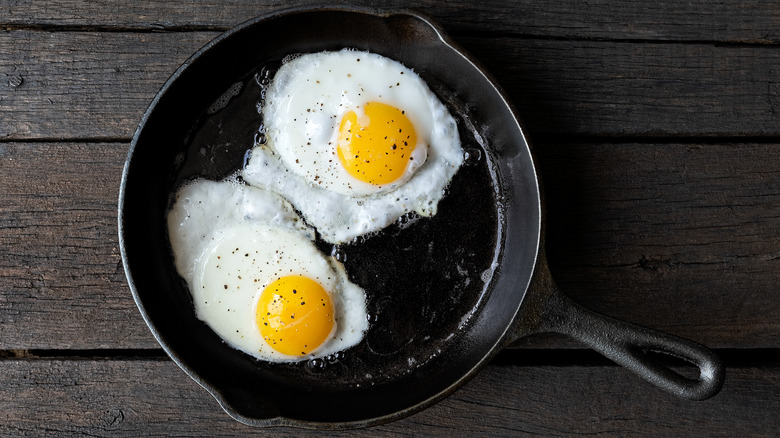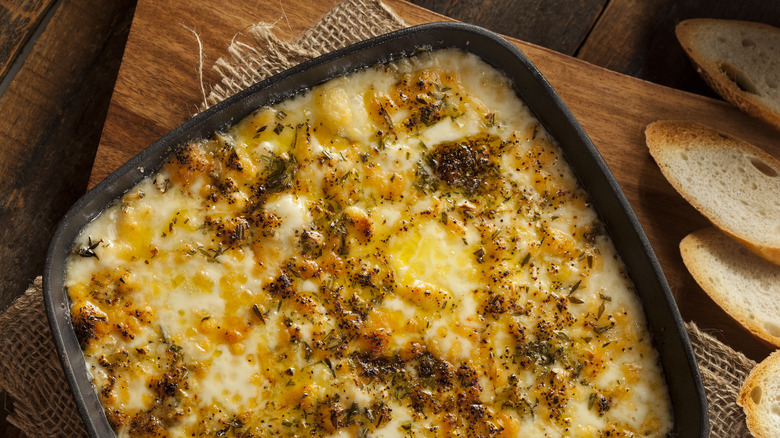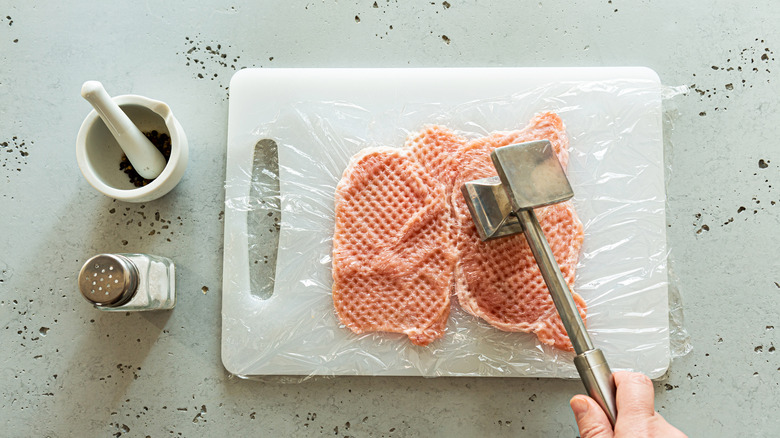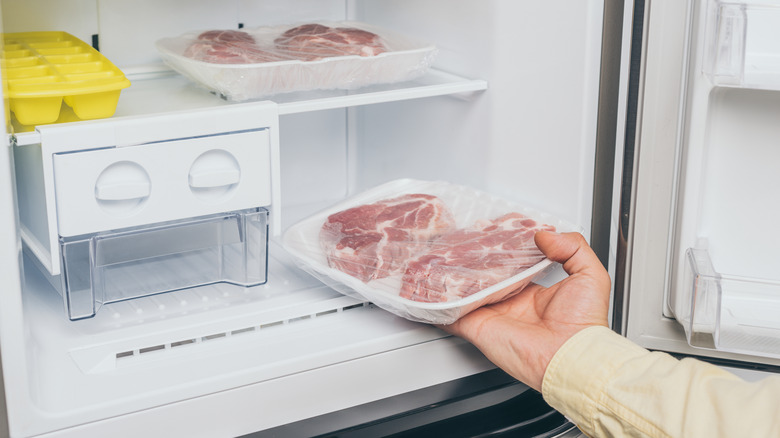The Absolute Best Uses For Your Cast Iron Skillet
So you have that cast iron skillet sitting in your kitchen, but you don't really use it all that often. Cast iron, for many reasons, can be intimidating. There's all the talk about "seasoning" your cast iron. Use it incorrectly and your expensive cookware investment is ruined. Clean it incorrectly and it's ruined. For reasons like these, and countless others, you may have shied away slightly from using your cast iron skillet on the regular.
However, you may be missing out. Cast iron skillets come in handy in a range of cooking situations — and not all of those situations even require you to actually cook in the skillet.
Intrigued? We thought you might be. Here are 15 of the absolute best uses for your cast iron skillet, so you can start using this amazing piece of cookware to its full potential (just maybe educate yourself on proper care and skillet seasoning, first?).
Searing steak
Hands down, one of the best uses for your cast iron skillet is searing steak. When you're choosing a searing vessel, you want to pick a thick-bottomed, high-quality pan — like a cast iron skillet. Cast iron skillets are preferred for searing due to their ability to retain high heat, as it comes to heat quickly, while distributing that heat evenly, according to Foodal. Searing in a cast iron skillet also makes it easy for you to cook using one piece of cookware and one piece of cookware only, as you can sear your steak in the skillet and then move the skillet directly into the oven to finish your steak to your desired doneness without ever transferring it to a new vessel.
As this Food Network recipe details, it's as easy as searing your steak for about three minutes on medium-high heat, slicing your steak as desired, and then popping that steak beneath your broiler for about four to six minutes.
One-pan dinners
While it's nice to be able to use only one cooking vessel to create the perfectly cooked steak, both inside and out, it's also great to use just one cooking vessel for your entire dinner. But don't think that one-pan dinners require sticking to your same-ol', same-ol' slow cooker recipes or your trusty casserole dish. You can use your cast iron skillet for tasty one-pan dinners, too.
Just like when searing steak, many cast iron skillet one-pan dinner recipes require you to use the skillet for a bit of searing on the stovetop before moving everything to your oven for finishing off. This Food Network cornbread-topped chili recipe is a good example of what you can do. It requires you to make your chili on the stovetop, before topping the chili with your biscuit batter, and moving it all to the oven to bake. Once finished, you can serve everything right from the skillet.
Baking cornbread
Speaking of cornbread, did you know that you can use your cast iron skillet for baking, too? And what's one of the most beloved traditional baking uses for your cast iron (at least in the south)? Cornbread! The cast iron skillet gives your cornbread a crispy crust that you simply cannot replicate using any other type of pan.
This Food Network cast iron skillet cornbread recipe is incredibly easy. You'll need to preheat your cast iron skillet in a 425-degree oven while you make your batter. Then, reduce the heat to 375 degrees and add some butter to the skillet. After it melts, pour the batter in and bake for about 25 minutes. While this recipe is for basic cornbread that's best topped with more butter or a slathering of jam, cornbread can be incredibly versatile, so you can add in extra ingredients to suit your tastes — from chiles to cheese.
Deep-dish pizza
Deep-dish pizza requires a few different things. You want it to be deep — obviously — with thick sides. You also want the crust to be relatively crispy, with a texture that's going to be strong enough to hold up to all of that saucy, cheesy goodness. Just as the cast iron skillet gives cornbread a crispy crust that can't be replicated in any other kind of cooking vessel, a cast iron skillet can give the same crispy exterior to your favorite deep-dish pizza recipe. Plus, the sides of most cast iron skillets are high enough to allow you to really build up that pizza to the depth you prefer.
If you don't already have a favorite deep-dish pizza recipe, check out this option from Food Network, which gives you all the directions needed to put together a delicious, traditional deep-dish pizza in your cast iron. Make sure to note the warning that the order of topping layers will impact your crust, though. The cast iron skillet cannot do all the work on its own, so you'll want to be sure to follow the recipe's instructions down to the letter to guarantee a crisp crust.
Cooking tortillas
Anyone who's had a homemade tortilla will tell you that homemade goods are worlds better than the packaged stuff. However, whether you are making homemade tortillas on your own or just heating up purchased corn tortillas, your cast iron skillet can come in handy.
According to Lodge — the cast iron brand, so you know you can trust them on all things cast iron — while, traditionally, tortilla makers use a tortilla press and comal, or flat griddle, for making tortillas from scratch, some wax paper and a cast iron pan will work for the average home cook. Press the tortilla dough between sheets of plastic wrap to get your desired shape, then cook the tortillas directly in your cast iron skillet with just a little vegetable oil for three to four minutes each. You'll be surprised by just how easy it is to make tortillas at home.
However, if you want to reheat some packaged tortillas, you won't want to use any oil — just heat. According to Bon Appetit, it's best to simply throw the tortillas in your cast iron skillet over medium-high heat for about 15-30 seconds on each side until they start to brown and smell toasty.
Cooking over an open fire
Whether you're camping in the backwoods or building a bonfire in the backyard, no home cook can deny the allure of cooking over an open fire. There's just something utterly human about gathering around the flame and attempting to cook in the ways of our forefathers. However, cooking over an open fire is much easier said than done, especially for those of us more accustomed to simply adjusting our heat with a flip of a switch, versus coaxing some coals. A cast iron skillet can make the process much easier.
Cast iron's rugged durability means you can heat it over an open flame and not worry about damaging your cookware, even if you set the cast iron directly on your coals. AllRecipes offers a few tips and tricks for cooking with your cast iron over an open flame, including how to use embers and coals to control your heat as best you can. Don't forget, though: beyond your cast iron, if you're cooking over a fire, you'll need a few extra pieces of equipment, too, like heat-resistant cooking utensils and oven mitts.
Baking a skillet cookie
For those who love their cookies crunchy on the outside and soft in the middle, the skillet cookie truly delivers. Served straight from the oven, no matter if they're extra-large or single-serving size, skillet cookies are always rich and gooey in the center, with a perfectly browned, crispy crust on the exterior edges. But replicating this restaurant favorite at home can be a hassle, or even impossible — unless, of course, you enlist your handy cast iron skillet.
Both cast iron's even heat distribution and reputation for forming crispy crusts where other cookware cannot make it ideal for this type of baking project. Sure, you may need to adjust your recipe to fit your particular size skillet... or, you could just buy a new cast iron skillet. After all, who doesn't need more cast iron in their kitchen?
For a giant chocolate chip skillet cookie, check out this recipe from Bon Appetit.
Roasting vegetables
But your cast iron skillet isn't just a great option for baked goods and searing steak. You can use it to put a sear or caramelized crust on just about anything, including vegetables. Toss your favorite baking sheet aside, because your next oven-roasted veggies are coming to you courtesy of your cast iron. Bon Appetit notes that cast iron skillets can give roasted vegetables a golden-brown hue and a crunchy exterior, thanks to the consistent, evenly distributed high heat cast iron provides.
To see the magic for yourself, just use your favorite roasted veggie recipe, but swap out the sheet tray for your cast iron. Potatoes, carrots, and more receive new life with the help of a little oil, salt, and spices, plus a short stint in the oven. Treehugger offers a few extra tips, such as pre-heating the pan in your oven before adding your veggies, and turning on your convection fan if you have one.
Stir-frying
Bon Appetit also says that stir-frying is one option you might not have considered for your cast iron skillet. Cast iron holds heat similarly to a wok, retaining its heat without dropping temperature when you add cold foods, but many of us don't have woks on hand. But, if you have a cast iron skillet, you can start stir-frying ASAP.
However, this advice comes with a caveat. Cook's Illustrated compared stir-frying a few different dishes in cast iron and discovered that, while cast iron works well when stir-frying beef dishes, the same could not be said for stir-frying noodle-based dishes. Noodles, the publication reported, stick to cast iron in a pretty unfortunate way and moving the noodles around so that they don't stick just resulted in the noodles disintegrating. The end product was a partially burnt, half-disintegrated noodle stir-fry, and a great big mess in the cast iron.
So, if you decide to stir fry in your cast iron skillet, proceed with caution.
Toasting chiles and spices
Many recipes ask for you to toast chiles or spices before adding them to a dish, resulting in a more refined, deeper flavor profile you can't achieve if you simply throw the ingredients into your dish without toasting. For many busy home cooks, though, the toasting process feels like a chore and one that you could easily skip. But toasting those chiles and spices could be just as easy as pulling out your cast iron skillet.
Fine Cooking recommends toasting your ingredients on a medium-high temperature in a cast iron skillet, heated until you can feel the warmth radiating off the pan. Then, add your ingredients one ingredient at a time. The publication further recommends wiping your skillet clean between toasting batches so you don't inadvertently flavor one ingredient with another and, if you're toasting multiple items, start with whole chiles and seeds first, before moving on to leaves and herbs, then ground spices, then ground chiles — essentially, moving from larger items to smaller items. This makes it easier to wipe your skillet clean between batches and also helps to prevent burning.
Frying eggs
When it comes to frying eggs, you may scoff at the idea of using your cast iron. Why would you do that when you already have a trusty non-stick pan and you've heard that eggs stick horrifically to cast iron? And while, yes, it's true that eggs can stick to cast iron much like the stir-fry noodles discussed above, and yes, most of us do have a non-stick pan that we automatically reach for at breakfast time, you can make some really good fried eggs — from sunny side-up to over-medium — in your cast iron skillet, with a crispy edge that contrasts nicely with your runny yolk.
Ranch chuck wagon cook Kent Rollins suggests heating your cast iron to medium-high before melting some butter in your pan. Then crack the egg into your skillet, pour some water around the outside edge, lower the heat, and cover. Let the egg stay as it is for a few minutes (based on how done you want it), then remove the lid, flip the egg, let it cook a few more seconds, and remove.
Baking cheese
Just like you can use a small cast iron skillet for making cornbread or skillet cookies, you can also use smaller cast iron skillets for baking cheese, leaving you with a delicious appetizer that you can serve right from your cookware. Don't have a small skillet? A big one works, too. (You just get more cheese, which is a win for everyone!)
Ina Garten recommends baking diced fontina cheese in a 12-inch cast iron pan, with olive oil, garlic, thyme, and rosemary. Placing the pan of cheese beneath your broiler results in melted, bubbling, browned cheese in less than 10 minutes. Then, once the pan is slightly cooled, you can serve the cheese from the pan alongside dipping bread or other accompaniments. Beyond fontina, you can also use this method with baked brie and gruyere.
You will find that cheese will stick to your cast iron, but the cast iron community on Reddit recommends using cold water and a scraper to loosen it up, not hot water.
As a meat mallet
We promised you some uses for your cast iron skillet that don't require you to actually cook inside of your cast iron skillet, and this is one of those uses. If you don't have a meat mallet (one of those items that you seem to not really think about buying until you actually need it in the moment), you can use your cast iron skillet. AllRecipes says to be sure to wrap your meat in plastic wrap, wax paper, or a zip-top bag and place it on a cutting board before you mash away. But, once your meat is ready, you can use your cast iron to go at it. AllRecipes also advises using both hands on the skillet handle, though, to avoid wrist injury.
No cast iron, but still need a meat mallet? You can also use a rolling pin, empty wine bottle, large book, or shatterproof measuring cup.
As a quick fix for thawing meat
Another way to use your cast iron pan for something beyond cooking? As a quick fix for thawing that frozen meat you forgot to defrost. According to Cuisine at Home, simply place your meat or fish (or even vegetables or fruit) onto an upside-down cast iron skillet (wrap the skillet in a plastic zip-top bag or plastic wrap first, for food safety). The frozen temperature of the meat transfers to the cast iron, so the meat thaws more quickly. Cuisine at Home claims using this hack, and turning the frozen item every 15 to 20 minutes, can cut your thawing time in half.
If you don't have a cast iron skillet, but do want to try this hack, Food Network says you can also use an aluminum baking sheet, as aluminum conducts heat and transfers temperatures much like cast iron. Using this method, you can safely thaw your item on the countertop for up to two hours.
As a makeshift panini press
Another unconventional way you can use your cast iron skillet is as a panini press — but there's a catch. You will actually need two cast iron skillets for this trick. A panini should be crispy-crunchy on the outside, but you also need a good deal of weight to get that characteristic flatness, and the combination of two cast iron skillets can deliver both.
Taste of Home shows you how it's done. All you need to do is preheat both skillets on medium-high heat. Then, assemble your panini and place it in your oiled pan (choose the larger of your two cast iron pans for your bottom pan). Place the opposite skillet right side up atop the sandwich. Put something heavy in the top skillet to help weigh it down, such as a heatproof kettle or another pan (this one doesn't need to be cast iron). Cook for four minutes and you're done!
